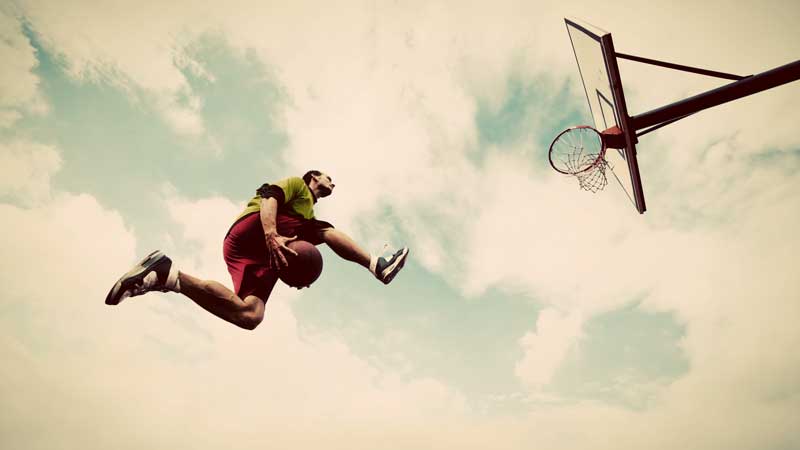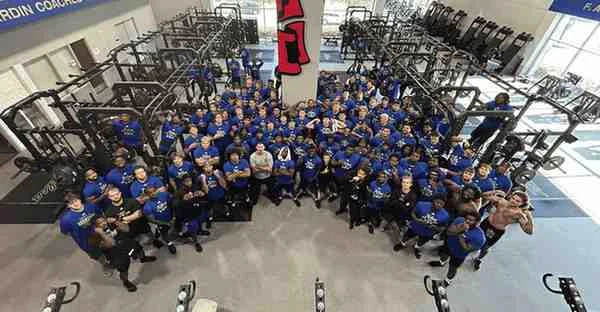
Every basketball junkie has dreams of dunking over their opponent on the court. It seems that is part of the right to athletic manhood. Every little kid always asks the older high school athlete if they can “slam”. Sometimes the response is I can get rim or can dunk a tennis ball. Once an athlete has broken “the dunk barrier”, they get creative, one-hand, two-hand, tomahawk, one step, two legs, reverse. Dreams of entering the NBA dunk contest are always in the back of player’s mind, and the 5’7 Spud Webb only encouraged everyone’s dreams.
The internet world of athletic training is built on these dreams. If you want to sell, you have to have a vertical jump program. There are thousands you can buy. Kelly Baggett had the first one that I thought was good. It had a good mix of exercises and a sound progression. There were many in between and many more that were just plain bad. Michael Jordan’s coach put a book out that was just plain bad. The program would work great for Jordan but no one else. A good recent one is Joel Smith’s Vertical Foundations.
Eventually, it became fun to see some crazy ideas. As I learned more, I realized how some of these books or even tools could become detrimental. I’m thinking of Strength Shoes. I had them back in high school. They do work. You do add inches and increase your speed, but it becomes a law of diminishing returns. Think about it. Your calves can only get so big and strong. From a recruitment pattern, your calves become the driver, and you lose out on glutes and hamstrings. I will never forget the first couple days I had them, and I was young, I jogged a couple of miles in them. I didn’t walk for days. In hindsight, they were not a good idea for me. I digress. Anyway, in the internet world of jumping, I did a Google search. A Google search has 44 million listings to improve your vertical jump. Ankle rocker has 44,000, most of which deal with rocking chairs and other things that have nothing to do with the function. And ankle rocker is where I have athletes that are picking up inches quickly.
The first athlete was more of a long play. He started at a younger age and would come and go with his extensive basketball schedule. His biggest issue was his tibial torsion. With his shins twisting, it was difficult to get lateral stability that created the issue of getting a stable base from which to jump. With an extensive amount of work to his hips, we finally got to the point where he could get his body lined up to jump in a vertical fashion. As a 6’1 guard, he needed to turn heads to get the attention he needed to move on to the next level. This is where the big drive came from to get a big jump. He needed an explosion. He started at 24 inches, and his last jump before leaving for college was 36.5”.
This is a progression of the first athlete. He started at 24 and progressed to 36 as shown in the videos below.
And this is where you end up when you put it all together.
Another athlete was a quick fix. A good athlete and a better hurdler came in for an assessment. We found that his ankle rocker was off. And he jumped with his back and used very little legs. But, being an explosive athlete he still jumped 25”. Three weeks later and some ankle work, he hit 31”. Since then, he has hit 32.4.
Both athletes and many more lack the ability to jump with their legs. As mentioned in my Ankle Rocker article, if an athlete cannot bend at the ankle, their body needs to rotate around the hips to gain velocity to throw the body vertically. And now the lift comes from the arm throw and the straightening of the spine. Legs just finish the movement. There is no drive. It is all throw. To get the drive from the legs, the ankles need to bend forward to create space for the hips to drop. So, the drive becomes vertical and from the hips, thighs and calves. To develop this, I created a circuit that we warm up with every workout. Some of the results have been incredible. I had two athletes put 5 inches on their vertical in 2-3 weeks.
After the athletes have the basic ankle rocker down and single leg squats, we move into the following workout.
The first exercise is what we call an ankle rocker pop. The athlete stands on the jump pad and goes into an ankle rocker position. Keeping the torso vertical, allow the ankles to bend forward, hold for a count and jump from that position. We want to make sure hands stay on hips, so we get a true reading on the just jump pad. We will do 4-6 repitions. More if the numbers continue to go up. In the second set, the athletes get into the same position but when they can’t go down any further, they will allow their hips to push back to the point where their shins and torso are parallel. Once in this position, with their hands on their hips, they will jump up. Once again, we measure the height. It is usually higher. On the third set, we will do the movement in a counter jump fashion. The movement should be short and quick. You can also drill this movement by pulling down hard, holding for a count, and extending up quickly, never leaving the ground.
The second exercise is a stair climb. Standing at the base of the stairs, the athlete will step onto the first step and push their shin forward trying to touch the edge of the next step without changing their body position. From that point, they will push down on the foot and extend the shin vertically from the ankle and drive up to the big toe. And continue to do so up the flight of the stair. Have them think about squeezing their glute at the top of the movement.
The third exercise is on my MVP Shuttle. The athlete will lie on their side with their foot underneath their hip. They will squat into a position where the shin comes forward and hip bends slightly and will do a single leg jump from that point. And upon landing, try to get back immediately into that same position. We start with a weight less than bodyweight so the movement can slow down to get a feel for it. Once the ankle works properly, we start adding weight.
Here is a great jump with great technique.
This vertical is 38.7”. Watch the shadow in the back.
Here is a 40 inch jump with feet turned out with a lot of glute recruitment. This is a 40 incher.
Another 40. Watch the ankles and short approach.
This has carried over into their sprints as well. I have seen big changes in an athlete’s sprint as well. They seem to have more pop and have increased their stride. Sometimes it is the little things that make the biggest impact.
[freelap-share]
[mashshare]




